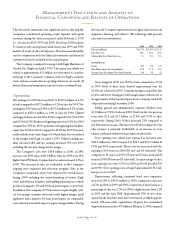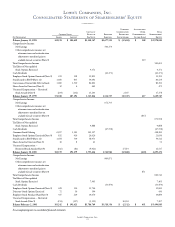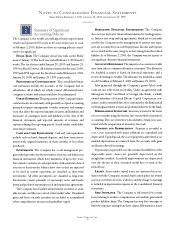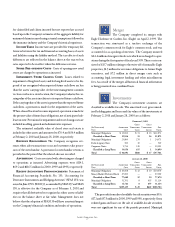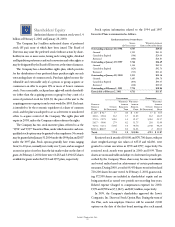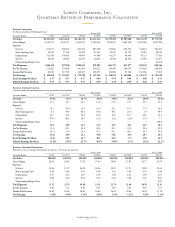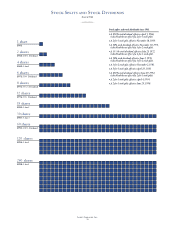Lowe's 2000 Annual Report Download - page 28
Download and view the complete annual report
Please find page 28 of the 2000 Lowe's annual report below. You can navigate through the pages in the report by either clicking on the pages listed below, or by using the keyword search tool below to find specific information within the annual report.
Lowe’s Companies, Inc.
26
Summary of Significant
Accounting Policies
The Company is the world’s second largest home improvement
retailer and operated 650 stores in 40 states from coast to coast
at February 2, 2001. Below are those accounting policies consid-
ered to be significant.
Fiscal Year The Company’s fiscal year ends on the Friday
nearest January 31. The fiscal year ended February 2, 2001 had 53
weeks. The fiscal years ended January 28, 2000 and January 29,
1999 each had 52 weeks. All references herein for the years 2000,
1999 and 1998 represent the fiscal years ended February 2, 2001,
January 28, 2000 and January 29, 1999, respectively.
Principles of Consolidation The consolidated finan-
cial statements include the accounts of the Company and its
subsidiaries, all of which are wholly owned. All material inter-
company accounts and transactions have been eliminated.
Use of Estimates The preparation of the Company’s finan-
cial statements in conformity with generally accepted accounting
principles requires management to make estimates and assump-
tions that affect the reported amounts of assets and liabilities and
disclosure of contingent assets and liabilities at the date of the
financial statements and reported amounts of revenues and
expenses during the reporting period. Actual results could differ
from those estimates.
Cash and Cash Equivalents Cash and cash equivalents
include cash on hand, demand deposits, and short-term invest-
ments with original maturities of three months or less when
purchased.
Investments The Company has a cash management pro-
gram which provides for the investment of excess cash balances in
financial instruments which have maturities of up to five years.
Investments, exclusive of cash equivalents, with a maturity date of
one year or less from the balance sheet date or that are expected
to be used in current operations are classified as short-term
investments. All other investments are classified as long-term.
Investments consist primarily of tax-exempt notes and bonds,
municipal preferred tax-exempt stock and repurchase agreements.
The Company has classified all investment securities as avail-
able-for-sale, and they are carried at fair market value. Unrealized
gains and losses on such securities are included in accumulated
other comprehensive income in shareholders’ equity.
Derivative Financial Instruments The Company
does not use derivative financial instruments for trading purpos-
es. Interest rate swap and cap agreements, which are occasionally
used by the Company in the management of interest rate expo-
sure, are accounted for on a settlement basis. Income and expense
are recorded in the same category as that arising from the related
liability. As of February 2, 2001, the Company was not a party to
any significant derivative financial instruments.
Accounts Receivable The majority of accounts receivable
arise from sales to commercial business customers. The allowance
for doubtful accounts is based on historical experience and a
review of existing receivables. The allowance for doubtful accounts
was $2.0million at February 2, 2001 and January 28, 2000.
Sales generated through the Company’s private label credit
cards are not reflected in receivables. Under an agreement with
Monogram Credit Card Bank of Georgia (the Bank), a wholly
owned subsidiary of General Electric Capital Corporation, con-
sumer credit is extended directly to customers by the Bank and all
credit program related services are performed directly by the Bank.
Merchandise Inventory Inventory is stated at the lower
of cost or market using the first-in, first-out method of inventory
accounting. The cost of inventory also includes certain costs asso-
ciated with the preparation of inventory for resale.
Property and Depreciation Property is recorded at
cost. Costs associated with major additions are capitalized and
depreciated. Upon disposal, the cost of properties and related accu-
mulated depreciation are removed from the accounts with gains
and losses reflected in earnings.
Depreciation is provided over the estimated useful lives of the
depreciable assets. Assets are generally depreciated on the
straight-line method. Leasehold improvements are depreciated
over the shorter of their estimated useful lives or term of the
related lease.
Leases Assets under capital leases are amortized in accor-
dance with the Company’s normal depreciation policy for owned
assets or over the lease term, if shorter, and the charge to earnings
is included in depreciation expense in the consolidated financial
statements.
Self Insurance The Company is self insured for certain
losses relating to workers’ compensation, automobile, general and
product liability claims. The Company has stop loss coverages to
limit the exposure arising from these claims. Self-insurance losses
note
1
Notes to Consolidated Financial Statements
Years Ended February 2, 2001, January 28, 2000 and January 29, 1999





